#PFLP-GC
Text
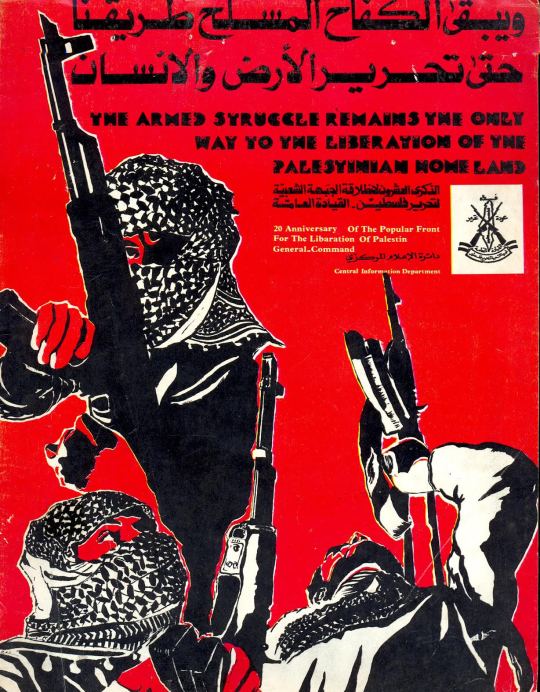
Armed Struggle Remains
Popular Front for the Liberation of Palestine - General Command (PFLP-GC) poster
Artist: Salim Kh
Published: 1989
294 notes
·
View notes
Text
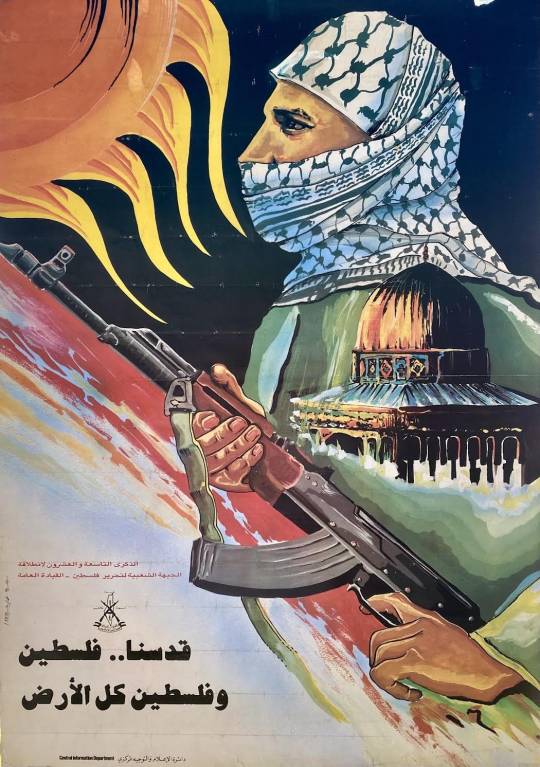
PFLP-GC poster
19 notes
·
View notes
Text
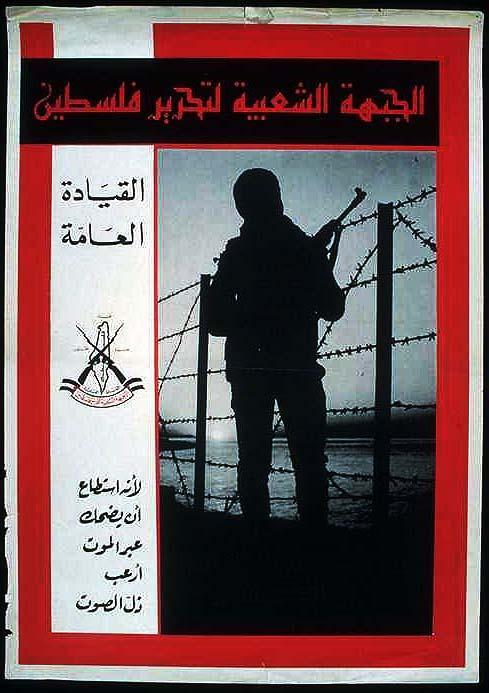
Unknown. Struggle-Return-Liberation. Circa 1968.
6 notes
·
View notes
Text
"[...]
The images of Palestinians that see we in our imperialist settings are usually pictures of depictions of devastation, bereavement and death. The humanity of the Palestinians is made conditional on their suffering, on what they’ve have lost, and what they endure. Palestinians get sympathy but not emancipation; emancipation would eat away at sympathy. This image of the victim produces the “good” Palestinian as a civilian, even better as a child, woman, or elder. Those who fight back, especially as part of organized groups are bad: the monstrous enemy that must be eliminated. But everyone’s a target. The fault for the targeting of the “good” Palestinians is thus placed on the “bad “ones, further justification for their eradication: every inch of Gaza provides a hiding place for terrorists. The policing of affect squeezes out the possibility of a free Palestinian.
[...]
The first intifada, in 1987, began with the “Night of the Gliders.” On November 25 and 26, two Palestinian guerrilla fighters from the PFLP – GC (Popular Front for the Liberation of Palestine – General Command) landed in Israeli occupied territory. Both were killed. One of them killed six Israeli soldiers and injured seven more before he died. Afterwards, the guerrilla became a national hero, and Gazans wrote “6:1” on their walls to taunt the IDF troops. Even PLO Chairman Yasser Arafat praised the fighters: “The attack demonstrated that there could be no barriers or obstacles to prevent a guerrilla who has decided to become a martyr” Nothing could hold them down or block them in if they had the will to fly.
[...]
In 2018, during the Great March of Return, Gazans used kites and balloons to evade Israeli air defenses and start fires in Israeli territory. It seems as if it was Palestinian youth that first started sending the fire kites. Later, Hamas got involved, creating the al-Zouari unit that specialized in making and launching incendiary kites and balloons. The kites and balloons boosted morale in Gaza, while damaging the Israeli economy and irritating Israelis living near the Gazan border. In response to an Italian journalist’s remarks about the “iconic new weapon” that was “driving Israel crazy,” Hamas leader Yahya Sinwar explained, “Kites are not a weapon. At most, they set on fire some stubble. An extinguisher, and it's over. They are not a weapon, they are a message. Because they are just twine and paper and an oil-soaked rag, while each battery of the Iron Dome costs $100 million. Those kites say: you are immensely more powerful. But you will never win. Really. Never."
There’s further context for reading kites in Gaza as messages from a people that refuses to submit. In 2011, 15 thousand Palestinian children on a Gazan beach broke the world record for the most kites flown at the same time. Many of the kites featured Palestinian flags and symbols, as well as wishes for peace and hope. An eleven-year-old, Rawia, who made her kite the colors of the Palestinian flag, said, “When I fly it, I feel like I’m raising my country and my flag up, up in the sky.” The 2013 documentary “Flying Paper,” directed by Nitin Sawhney and Roger Hill, tells the story of some of the young kite fliers. “When we fly kites, we feel like we are the ones flying in the sky. We feel that we have freedom. That there is no siege on Gaza. When we fly the kite, we know that freedom exists.” Earlier this year, kites were flown at solidarity demonstrations that took place around the world, expressing and amplifying a hope and a will for Palestinian freedom.
[...]
In 1998, Palestinians built Yasser Arafat International Airport. In 2001, during the second intifada, Israeli bulldozers demolished it. As Hind Khoudary explained, the airport was deeply interconnected with the dream of Palestinian statehood. She interviewed workers who built the runway that was reduced to rubble and sand. As Khoudary writes, “Gaza airport was more than a project. It was a symbol of freedom for Palestinians. Flying the Palestinian flag in the sky was the dream of every Palestinian.”
The paragliders who flew into Israel on October 7 continue the revolutionary association of liberation and flight. Although imperialist and Zionist forces try to condense the action into a singular figure of Hamas terrorism, insisting against all evidence that with the extermination of Hamas Palestinian resistance will disappear, the will to fight for Palestinian freedom precedes and exceeds it. Hamas wasn’t the subject of the October 7 action; it was an agent hoping that the subject would emerge as an effect of its action, the latest instantiation of the Palestinian revolution.
Words used by Leila Khaled to defend the justness of the PFLP’s hijacking tactic apply equally to October 7. Khaled writes: “As a comrade has said: We act heroically in a cowardly world to prove that the enemy is not invincible. We act "violently" in order to blow the wax out of the ears of the deaf Western liberals and to remove the straws that block their vision. We act as revolutionaries to inspire the masses and to trigger off the revolutionary upheaval in an era of counter-revolution.”
[...]
In the six months since the beginning of Israel’s genocidal war on Palestine, there has been a surge in global solidarity with Palestine, one reminiscent of the previous wave of the 1970s and 1980s. As Edward Said told us, by the end of the seventies “there was not a progressive political cause that did not identify with the Palestinian movement.” Solidarity with Palestine united the left, knitting liberation struggles together in a global anti-imperialist front. As historian Robin D.G. Kelly says, “We radicals regarded the PLO as a vanguard in a global Third World struggle for self-determination traveling along a “non-capitalist road” to development.” The militancy and dedication of the Palestinian struggle made its revolutionary combatants models for the left.
The struggle for Palestinian liberation today is led by the Islamic Resistance Movement — Hamas. Hamas is supported by the entirety of the organized Palestinian left. One might have expected that the left in the imperial core would follow the leadership of the Palestinian left in supporting Hamas. More often than not, though, left intellectuals echo the condemnations that imperialist states make the condition for speaking about Palestine. In so doing, they take a side against the Palestinian revolution, giving a progressive face to the repression of the Palestinian political project, and betraying the anti-imperialist aspirations of a previous generation. "
83 notes
·
View notes
Text
New Rho Under Siege
CW: discussion and a few images of urban conflict some may find disturbing. I've tried to avoid any actual depictions of death however.
The Locked Tomb series receives a lot of gushing praise (quite rightly) for its intricate and complex depictions of relationships and love, sexuality and gender. But something I've seen less praise for (though I'm sure it exists) is the incredibly rich depiction of what an urban environment during warfare and civil strife looks like.
One of the unfortunate facts of urban warfare is that civilians are almost inevitably present, even in the most dire circumstances. Take the Bakhmut as an example. Despite months of fighting, thousands lived on in the city and region right to at least the very closing moments. This is despite the city being essentially entirely destroyed.



👆 civilians still lived through these conditions.
New Rho in Nona the Ninth feels incredibly lived in. The city supposedly contains ~9 million people, and you can believe it. There are all sorts of people, there are different groups and socio-economic areas, people have different responses to the situation they find themselves under, but they all living complex lives. This goes well beyond the key characters or even the side characters, but is captured by the existence of a barter economy, background vigilante and militia groups, the daily grind of workers desperately seeking ad hoc jobs.
They walked alongside all the other workers - the ones who didn't get picked up in the morning in the worker vans, or didn't have a job that merited a worker van, or didn't have a job but lived in hope - and they all trudged slowly through the street in clusters, parting only when a truck ground through, the driver leaning on the horn if someone didn't move out of the way quick enough.
I reckon some of the super fans here could pull out all sorts of fascinating little details in the world building of New Rho to discuss here.

[A civilian woman with a grocery bag walks through a levelled market in Grozny, Checnya during the Chechen War]
The Irish Troubles produced a number of iconic photos showing the dichotomy of urban conflict amongst civilians.
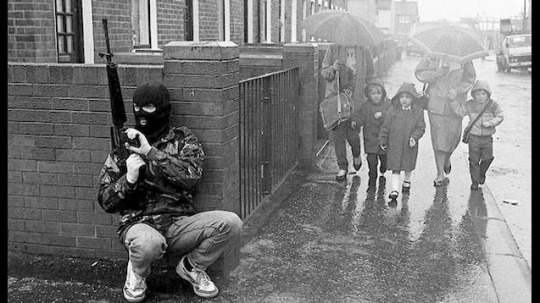


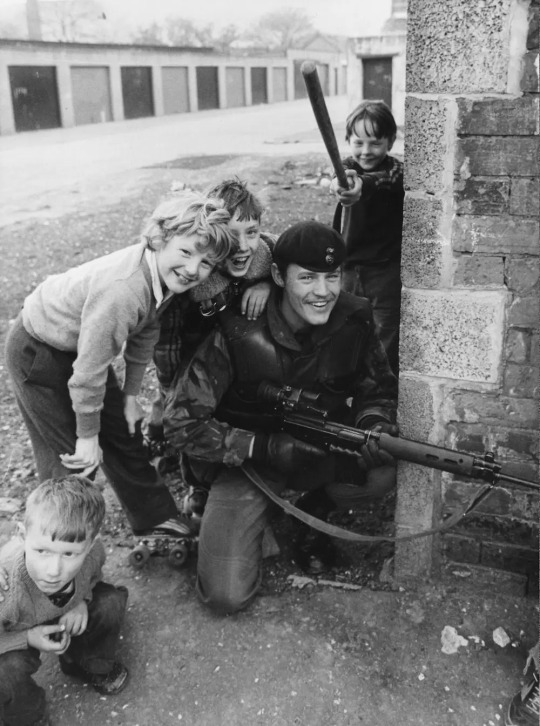
Perhaps one of the best parallels would be life in Palestine, particularly the Gaza Strip. The Gaza Strip, with a population of >2 million has lived under blockade for many years with frequent intervention/incursion by Israel.

[Aftermath of Israeli strikes in Gaza City, 2021]
One of the interesting parallels with Palestine is the plethora of different actors and resistance groups, just a fractious and secretive as New Rho's Blood of Eden and other militants, and who often seem to spend more time fighting themselves and civilians rather than their main enemy.
The Marxist-Leninist Popular Front for the Liberation of Palestine (PFLP) gave us the splinter groups PFLP-SC (Special Command), PFLP-GC (General Command), PFLP-EO (Executive Order), Palestinian Popular Struggle Front, Democratic Front for the Liberation of Palestine, Popular Revolutionary Front for the Liberation of Palestine, and had complex intertwined relations with groups like the Black September Organisation, Palestinian Liberation Front, Arab Liberation Front, Palestinian National Salvation Front, the Abdul Nidal Organisation, Fatah al-Intifada, Vanguard for the Popular Liberation War - Lightning Forces, and dozens of others. On the Islamist side there is similarly a plethora of groups, from Hamas, to Palestinian Islamic Jihad, Sheikh Omar Hadid Brigade (Islamic State in Gaza), the al-Aqsa Martyrs' Brigade, the Army of Islam, and Jund Ansar Allah. It's almost comical to write them out.
New Rho itself is home to many refugees and "re-settled" peoples, which is somewhat reminiscent of Palestinians and the related conflict spilling into Lebanon, Jordan and other neighbouring areas. The complexity and number of groups involved skyrocket.
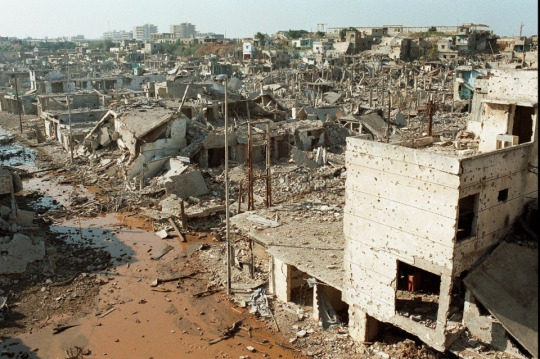
[Shatila Camp, Lebanon during the War of the Camps]
Rarely is war as simple as "Good Guys vs. Bad Guys" or even "Bad Guys vs. Bad Guys." There is almost always a vast number of interest groups and competing organisations at stake, even in some of the more black and white wars like WW2. Muir just hits this nail right on the head in my opinion.
You could also make similar parallels to the Syrian Civil War, which has an equally complex mix of militants and groups. Despite all of that, of course, life still goes on. School kids still attend school, even in bullet ridden buildings.


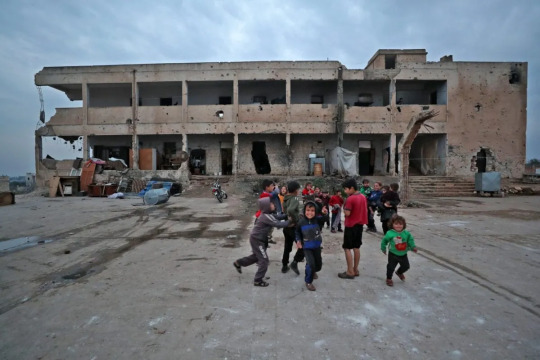
These kids are your Hot Sauce and Honesty and Kevin and Beautiful Ruby.
Typically the books I've read depicting a place under siege or at war (at least in sci-fi / fantasy) have a focus on the main characters leading the war effort. There may be issues of water or food shortages, but they're largely somewhat abstract political complications being dealt with by key rulers or the like. Often times war is simply sanitised completely (think Star Wars), or it is portrayed through a military lens, or when it deals with civilians it focuses on the destruction and death of civilian life.
I just found Nona wonderful in depicting the mundanity, the boredom, the regularity of life in a war zone, as well as the sudden shocks of change and turmoil and fear, and then as well the glimpses of joy and pleasure that humans still experience. I'm just really quite blown away by Tamsin Muir, and I wonder if she had a specific conflict as inspiration for her writing here.
31 notes
·
View notes
Text
퍼핀 막힘 대체 브라우저 puffin apk 우회
퍼핀 막힘 대체 브라우저 puffin apk 우회 가능합니다.
퍼핀 막힘 대체 브라우저 puffin apk 우회 사이트 <
퍼핀 사이트 PC 에서도 대체 우회 브라우저 사용 가능합니다. 하루사용량 마음대로 할수있고 추적 걱정마세요.
퍼핀 우회 안됨 하시는분들을 위해서 VPN puffin 대체 막힘 PRO APK 브라우저 추천 했습니다. 유료화 전혀 사실 아니니깐 휘둘리지 마시기 바랍니다.





팔레스타인해방인민전선의 안와르 라자(Anwar Raja) 총사령부는 다마스쿠스에서 AP통신과의 인터뷰에서 이스라엘의 공습이 시리아 국경 근처의 레바논 동쪽 마을인 쿠사야를 강타했다고 말했습니다. 그는 부상자 중 2명은 위독한 상태라고 말했습니다.
또 다른 PFLP-GC 관리인 레바논에 본부를 둔 Abu Wael Issam은 AP에 퍼핀 막힘 대체 브라우저 puffin apk 우회 그의 그룹이 "적절한 시간에" 보복할 것이라고 말했습니다. 그는 이번 공격이 그의 그룹이 "이스라엘 적과의 싸움을 격화시키는 것"을 막지는 못할 것이라고 덧붙였다.
익명을 요구한 한 이스라엘 관리는 이스라엘이 이번 사건에 관여했다는 사실을 부인했습니다. 이스라엘은 일반적으로 외국 보고서에 응답하지 않습니다.
바논군과 레바논의 무장 헤즈볼라 그룹도 공습에 대해 즉각적인 언급을 하지 않았습니다. 그러나 익명을 요구한 레바논 보안 소식통은 AFP에 "기지의 무기 창고에서 오래된 로켓이 폭발했고 5명의 전투기가 사망했다"고 말했다.
스라엘의 반응에 대해 질문을 받은 라자는 이스라엘이 거부한 이유를 "레바논 상황의 민감성"으로 돌렸습니다. 이는 이스라엘의 공격을 인정하면 헤즈볼라가 보복할 것이라는 암시였습니다.
이스라엘은 지난 4월 레바논 남부에서 공습을 시작했는데, 이는 무장세력이 이스라엘에 거의 30여 발의 로켓을 발사해 시리아 노동자 2명에게 부상을 입히고 일부 재산 피해를 입힌 지 하루 뒤였습니다.
당시 이스라엘에 발사된 로켓은 이스라엘군이 예루살렘에 있는 알아크사 모스크를 습격하고 람단 기간 동안 숭배자들을 공격한 것에 대한 대응이었습니다.
PFLP-GC는 레바논-시리아 국경을 따라 주둔하고 있으며 양국에 군대가 주둔하고 있습니다. 이 그룹은 과거에 이스라엘에 대한 공격을 수행했습니다.
이 무장 단체는 1968년 엘 알 제트 여객기 납치, 1969년 취리히 공항에서 다른 여객기 기관총 사살 등 이스라엘에 대한 주요 공격으로 유명해졌습니다. 취리히에서 텔아비브까지, 탑승한 47명의 승객 전원이 사망했습니다.
다마스쿠스에 기반을 둔 그룹은 또한 레바논의 기지에서 이스라엘에 대한 공격을 수행했습니다.
1985년 이스라엘이 레바논을 침공하는 동안 PFLP-GC는 이스라엘 군인 3명을 체포하고 대부분 팔레스타인, 레바논, 시리아 포로 1,100명 이상과 교환하는 조건으로 그들의 석방을 협상했습니다.
세계에서 가장 부유한 사람 중 한 명인 변덕스러운 억만장자가 3년여 만에 ���음으로 중국을 방문합니다.
수요일에 그는 베이징에서 Jin Zhuanglong을 만나 "신에너지 자동차 및 지능형 커넥티드 자동차의 개발"에 대해 논의했다고 산업 정보 기술부가 발표했습니다.
자세한 내용은 공유하지 않았습니다. Tesla 대표는 Musk의 여정에 대한 추가 정보에 대한 AFP의 퍼핀 막힘 대체 브라우저 puffin apk 우회 요청에 응답하지 않았습니다.
머스크는 중국에서 광범위한 사업 이해관계를 갖고 있으며 화요일 친강 외교부 장관에게 그의 회사는 "중국에서 사업을 계속 확장할 의향이 있다"고 말했습니다.
중국 언론은 Tesla가 화요일 해산물, 뉴질랜드 양고기, 전통적인 베이징식 된장국수를 포함하는 16코스 만찬으로 CEO를 베이징으로 환영했다고 보도했습니다.
중국은 세계 최대 전기차 시장이며 테슬라는 지난 4월 상하이에 2019년 착공한 기가팩토리에 이어 두 번째 대규모 공장을 상하이에 건설한다고 발표했다.
화요일 진과의 회담에서 머스크는 또한 중국과 미국 간의 경제적 "분리"에 반대한다고 베이징은 말했습니다.
머스크는 "미국과 중국의 이익은 서로 뗄 수 없는 결합된 쌍둥이처럼 서로 얽혀 있다"고 덧붙였다.
머스크의 중국과의 광범위한 비즈니스 관계는 워싱턴에서 눈썹을 치켜세웠습니다. 조 바이든 대통령은 지난 11월 머스크의 외국과의 관계가 면밀히 조사할 가치가 있다고 말했습니다.
그리고 그는 자치령인 대만이 중국의 일부가 되어야 한다고 제안함으로써 논란을 불러일으켰습니다. 이는 중국 관리들이 환영하는 입장이지만 대만을 크게 화나게 했습니다.
비평가들은 머스크와 중국을 연결하는 산업 관계를 지적하며, 중국은 점점 더 미국과 관계를 악화시키고 있습니다.
마오닝(毛寧) 중국 외교부 대변인은 화요일 "중국을 더 잘 이해하고 상호 이익이 되는 협력을 촉진하기 퍼핀 막힘 대체 브라우저 puffin apk 우회 위해" 국제 간부들의 방문을 환영한다고 말했습니다.
North Geisum에서 PetroGulf의 생산량은 생산 시작 당시 하루 4,000배럴(BOPD)에서 현재 19,000BOPD로 급증했다고 성명서가 밝혔습니다.
한편, 확인된 매장량은 2023년 상반기 동안 1억 1,800만 배럴에서 약 2억 300만 배럴로 증가했습니다.
El-Molla 장관은 새로운 확장이 기존 시설과 새로운 시설을 통해 석유 자산을 극대화하려는 국가 전략에 속한다고 설명했습니다.
PetroGulf Misr는 후르가다에서 북쪽으로 70km 떨어진 홍해에 위치한 North Geisum, North-East Geisum 및 South Geisum을 포함하는 중앙 수에즈 만의 유전 그룹을 감독합니다.
PetroGulf Misr는 Egypt General Petroleum Company, Cheiron 및 Kuwait Petroleum Corporation의 자회사인 Kufpec 간의 합작 투자 회사입니다.
최근 공식 수치에 따르면 이집트의 원유 수출은 2023년 2월에 전년 대비 38.7% 감소한 6억 3,500만 달러를 퍼핀 막힘 대체 브라우저 puffin apk 우회 기록했습니다.
한편 같은 달 원유 수입액은 전년 동기 대비 38.5% 급증한 9억7400만 달러를 기록했다.
이집트는 최근 지중해와 나일 삼각주 지역의 12개 신규 블록에서 천연가스 및 원유 탐사를 위한 새로운 국제 퍼핀 막힘 대체 브라우저 puffin apk 우회 입찰을 개최할 계획이라고 발표했습니다.
1 note
·
View note
Text
@BUNKUROI(黒井文太郎)
日本赤軍。
国際テロ界では泡沫で、ワディ・ハダド派に転がり込んで面倒みてもらい、KGBが裏で糸を引くテロ犯罪ネットワークの鉄砲玉役に単に使われて人殺しをやり、それからアサド父の極悪秘密警察の手駒に成り下がったPFLP-GCに拾ってもらっただけの人たち
Twitter for iPhoneから

1 note
·
View note
Note
Can you run-down the difference between PFLP and PFLP-GC?
The PFLP was formed in 1967 by the merging of three separate groups. One of these three groups was the Palestinian Liberation Front (PLF), a Palestinian nationalist resistance movement founded by Ahmad Jibril.
Around one year after merging to form PFLP, Jibril took those loyal to him and formed a splinter group, the PFLP-GC (General Command). He believed that the PFLP spent too much time playing politics and waxing philosophical and not enough time carrying out attacks and fighting Israel. He argued that the PFLP was more of an organization of the “Palestinian elite” and intellectuals who’d rather read and discuss Marx in their lofty homes than actively carry out an armed struggle against Israel.
Almost immediately, Jibril began his attacks against Israel. For a time, he’d carried out similar attacks while part of the PFLP, using their name, but these operations were apparently conducted on his own - independent of the rest of the organization’s leadership, which led to friction and his eventual departure.
The PFLP was/are a group with a clear, stated objective, a clear political philosophy, and a vision for an eventual solution.
With the PFLP-GC...that’s not the case. Though they follow a loose set of ideals, they were more about direct, immediate action. The PFLP-GC appealed to some of the most disenfranchised Palestinians who didn’t care much for politics or a clear end-goal beyond striking back at Israel, with Jibril training them to be capable fighters with one goal in mind - guerrilla attacks against Israel.
Jibril doesn’t care for politics or imagery, and focuses instead on attacks against Israel.
And that’s the biggest difference between the two - PFLP have for years attempted to enter the political fray and establish themselves internationally - while PFLP-GC views such a desire as a disgrace, preferring instead to focus all energy on coordinating attacks.
The PLF was itself heavily backed by Syria, and that backing transferred to the PFLP when the groups merged. When Jibril splintered to form the PFLP-GC, he maintained close ties with the Syrian government - ties that over time led many to question his allegiances, causing friction and splintering within his organization. Some opponents and former soldiers of his began likening him more to right-wing/reactionary leaders than the leftists he once associated with.
PFLP-GC opposed Arafat, opposed the PLO, and opposed any organizations that sought a solution through political means, going so far as to vocally berate Palestinians who supported Arafat & the PLO.
The PFLP-GC waned over the years, as have most Palestinian factions, but remained somewhat active within Syria. Recently, they fought alongside Assad’s forced against Palestinians in the Yarmouk refugee camp in a battle that was the last straw for many still loyal to Jibril and the PFLP-GC.
Many who had remained with the PFLP-GC up to this point defected following this battle in Yarmouk, having lost faith in their leadership and questioning why they as Palestinians were actively engaged in warfare against rebels defending Palestinian refugees.
“One of his fighters, who gave a pseudonym, Abu Jihad, said he and dozens of others had joined the rebels on Sunday. He said they had been manning checkpoints ostensibly to protect the camps, but had been asked to fight rebels instead.
“I felt that we became soldiers for the Assad regime, not guards for the camps, so I decided to defect,” he said, adding that security forces stood by and watched as they fought the rebels, without supporting them.
“I felt that the regime doesn’t care about us,” he said. “Now I am fighting with the right side. We were hosted by the Syrian people, not the Assad regime, when we came to this country in 1948, and we should reward this favor.””
New York Times
Since the Battle of Yarmouk, the group has been in relative shambles with fractured leadership, with Jibril having fled Syria.
This was kinda shotgunned but I hope I managed to answer your question. If not, or if you were interested in something more specific, let me know!
7 notes
·
View notes
Note
which groups are the most dangerous
Here’s a list:
Abdallah Azzam Brigades (AAB)
Abu Nidal Organisation (ANO)
Abu Sayyaf Group (ASG)
Al-Ashtar Brigades (AAB)
Al-Murabitoun
Al-Muwaqi'un Bil Dima
Al Qaida
Al Qaida in the Arabian Peninsula (AQAP)
Al Qaida in the Indian Subcontinent (AQIS)
Al Qaida in the Islamic Maghreb (AQIM)
Al Shabaab
Al-Aqsa Martyrs' Brigade (AAMB)
Al-Gama'a al-Islamiyya (AGAI)
Ansar al-Islam (AI)
Ansar Dine
Armed Islamic Group (GIA)
Aryan Strikeforce
Asbat Al-Ansar (AAA) (The League of Partisans)
Atomwaffen Division
Aum Shinrikyo
Blood & Honour (B&H)
Babbar Khalsa International (BKI)
Boko Haram
Caucasus Emirate
Combat 18 (C18)
Ejército de Liberación Nacional (ELN)
Euskadi Ta Askatasuna (ETA)
Fatemiyoun Division (FD)
Front de Libération du Macina
Fuerzas Armadas Revolucionarias de Colombia (FARC)
Gulbuddin Hekmatyar
Gulbuddin Hekmatyar's Faction of the Hezb-e Islami, Hezb-e Islami Gulbuddin (HIG)
Hamas (Harakat Al-Muqawama Al-Islamiya) (Islamic Resistance Movement)
Haqqani Network
Harakat al-Sabireen (HaS)
Harakat ul-Mudjahidin (HuM)
HASAM (Harakat Sawa'd Misr)
Hay'at Tahrir al-Sham
Hizballah
Hizbul Mujahideen
Indian Mujahideen (IM)
International Relief Fund for the Afflicted and Needy - Canada (IRFAN – CANADA)
International Sikh Youth Federation (ISYF)
Islamic Movement of Uzbekistan (IMU)
Islamic Revolutionary Guard Corps' Qods Force
Islamic State
Islamic State – Bangladesh
Islamic State – Democratic Republic of the Congo
Islamic State East Asia
Islamic State in the Greater Sahara
Islamic State – Khorasan Province (ISKP)
Islamic State in Libya
Islamic State – Sinai Province (ISSP)
Islamic State West Africa Province
Jaish-e-Mohammed (JeM)
Jama’at Nusrat Al-Islam Wal-Muslimin
James Mason
Jaysh Al-Muhajirin Wal-Ansar (JMA)
Jemaah Islamiyyah (JI)
Kahane Chai (Kach)
Kurdistan Workers Party (PKK)
Lashkar-e-Jhangvi (LJ)
Lashkar-e-Tayyiba (LeT)
Liberation Tigers of Tamil Eelam (LTTE)
Movement for Oneness and Jihad in West Africa (MOJWA)
Palestine Liberation Front (PLF)
Palestinian Islamic Jihad (PIJ)
Popular Front for the Liberation of Palestine - General Command (PFLP-GC)
Popular Front for the Liberation of Palestine (PFLP)
Proud Boys
Russian Imperial Movement
Sendero Luminoso (SL)
Taliban
Tehrik-e-Taliban Pakistan (TTP)
The Base
Three Percenters
World Tamil Movement (WTM)
#answers to questions#Extreme groups#high control groups#dangerous groups#list of extreme groups#document dump
7 notes
·
View notes
Link
Over the past decade, as the prospects of peace between Israelis and Palestinians became ever slimmer, there has been a growing attention to—and, in some quarters, acceptance of—the Boycott, Divestment, and Sanctions movement targeting Israel, or BDS. Those drawn to the cause have likely come across the US Campaign for Palestinian Rights, a Virginia-based nonprofit organization that serves as the American umbrella group of the BDS movement and is arguably the most prominent promoter of BDS in the United States. The US Campaign, which is officially called Education for Just Peace in the Middle East, coordinates the efforts of 329 different pro-BDS organizations “working to advocate for Palestinian rights and a shift in US policy … bound by commonly shared principles on Palestine solidarity as well as our anti-racism principles,” according to the group’s website.
But as Tablet confirmed , the group also helps facilitate tax-exempt donations to a Palestinian coalition that includes Hamas, Palestinian Islamic Jihad, the Popular Front for the Liberation of Palestine, and other groups the U.S. State Department designates as terror organizations.
The US Campaign, Tablet has learned, is the fiscal sponsor of a group called the Palestinian BDS National Committee (BNC), the main West Bank and Gaza-based cohort advocating for sanctions against Israel. The BNC was created in 2007 in Ramallah with the intention of serving as the Palestinian arm of the international BDS campaign. According to the BNC’s website, one of the group’s members is the Council of National and Islamic Forces in Palestine, commonly known as PNIF. Among PNIF’s members are five different groups designated by the US as terrorist organizations, including Hamas, the Popular Front for the Liberation of Palestine (PFLP), the Popular Front – General Command (PFLP-GC), the Palestine Liberation Front, and Palestinian Islamic Jihad (PIJ). Since its founding, the BNC has frequently and openly collaborated with known leaders of these terror organizations: In 2015, for example, the BNC held a press conference to pressure the Palestinian government not to import gas from Israel, featuring a speech by Khalida Jarrar, then a member of the Palestinian parliament for the PFLP and still an active official in the terror group. A video of the BNC-hosted press conference features Jarrar seated alongside BNC secretariat member Omar Barghouti.
16 notes
·
View notes
Link
The Arab nations were unhappy that they lost the war they launched against Israel in 1948. So they came up with a brilliant plan to create a weapon that could be used to destroy Israel, a weapon that would automatically grow stronger with the passage of time, which would be a military, psychological, and diplomatic weapon all at the same time. Best of all, someone else would pay for it.
They invented the Palestinian refugee, a creature like no other refugee, because Palestinian refugee status in hereditary. They established UNRWA, an agency whose charter – unlike all other refugee relief agencies ever – was not to resettle refugees, but rather to increase their number. And the West, which pays almost all of the bills of the UN, bought into it out of cowardice and lack of will to oppose the Arabs, who had all that oil, after all.
And so the “refugee camps,” which more and more became to resemble permanent neighborhoods, came into being in several nations and became breeding grounds for recruits to the multiplicity of Palestinian terror organizations – Fatah, Hamas, PFLP, DFLP, PFLP-GC, Palestinian Islamic Jihad, Abu Nidal group, etc. Unemployed young Palestinian men flocked to these groups in order to lend purpose to their lives. The growth of anti-Israel and international terrorism since 1960 was caused to a great degree by the activities of these groups. Palestinian terrorists popularized airline hijacking and suicide bombing, leading directly to 9/11 and other atrocities. Thus was the West paid back for its investment.
4 notes
·
View notes
Text
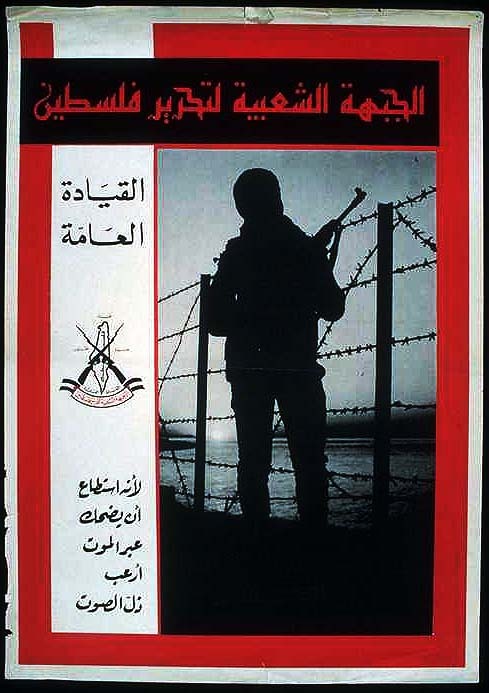
Struggle-Return-Liberation
Popular Front for the Liberation of Palestine - General Command (PFLP-GC) poster
Artist: unknown
Published: Circa 1968
50 notes
·
View notes
Link
0 notes
Text
Ahmed Jibril, founder of pro-Syrian Palestinian guerrilla faction, dies at 83
Ahmed Jibril, founder of pro-Syrian Palestinian guerrilla faction, dies at 83
Ahmed Jibril, whose Popular Front for the Liberation of Palestine – General Command was one of the main guerrilla groups fighting against Israel in the 1970s and 1980s and more recently backed Syria’s government in civil war, died in Damascus on Wednesday. He was 83.
“He has dedicated his life to serving Palestine and the front and stayed the course until his death,” the PFLP-GC, which is…
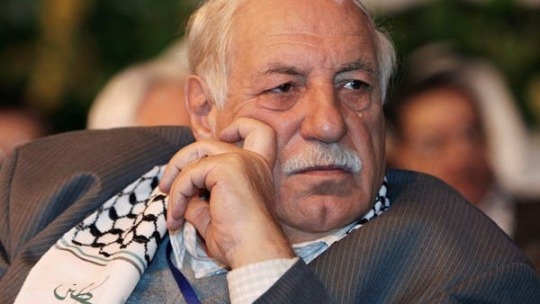
View On WordPress
0 notes
Photo
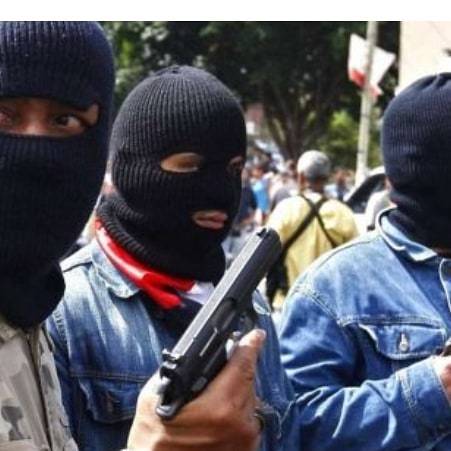
#denuncia #colectivosasesinos 📌Elementos palestinos pertenecientes al Frente Popular para la Liberación del Comando General Palestino (PFLP-GC por sus siglas en ingles) y del Ejército de Liberación de Palestina (ELP por sus siglas en español) junto al grupo político-terrorista libanés Hezbolá entrenaron a terroristas chiítas bahreiníes, yemenitas y grupos de venezolanos de las Fuerzas Populares Venezolanas creada por el dictador latinoamericano Nicolás Maduro y conocidas como “Colectivos” en campamentos cercanos a Damasco. 📌A través de fuentes de un grupo de oficiales disidentes sirios auto-exiliados en Líbano y Egipto se conoció un comunicado que publicó el diario árabe Al-Hayat con sede en Londres. 📌El comunicado de los militares que abandonaron el ejército sirio indica que el régimen de Assad y el Cuerpo de la Guardia Revolucionaria Islámica de Irán (IRGC por sus siglas en inglés) supervisaron y financiaron el entrenamiento de terroristas islámicos y latinoamericanos. 📌El comunicado de los militares sirios, que abandonaron el ejército por no aceptar lo que consideraron ordenes inmorales de represión, tortura, desaparición y crímenes de personas inocentes que nada tenían que ver con terrorismo contra el régimen sirio, denuncia con detalles cientos de delitos cometidos por el ejército que cumplía órdenes de masacrar gente inocente impartidas por Maher Al-Assad (hermano del presidente Bashar Al-Assad) también indica que el Frente para la Liberación del Comando General Palestino y el Ejército de Liberación de Palestina se mantuvieron leales a Irán y al régimen de Assad durante los siete años de guerra civil siria, y trabajaron arduamente en el entrenamiento y la capacitación de elementos jihadistas provenientes de Yemen, Bahrein y un grupo de unos 200 venezolanos pertenecientes a las milicias populares del régimen de Caracas. https://www.instagram.com/p/Bs9OX6JHNz-/?utm_source=ig_tumblr_share&igshid=1gjavxpijbanz
0 notes
Quote
712 名前:名無しさん@1周年[] 投稿日:2017/04/09(日) 13:41:11.99 ID:JJOTJ3W20シリアで活動する武装グループ テロ組織の一部ISIL レバント征服戦線(*) ヌスラ戦線(*) アラブ革命の先兵 ホラサン・グループ(*)シャビーハ 民族救済司令部 シリア・イスラム戦線 アフラール・シャーム(*)シリア電子軍 アラブ共産主義者機構 民主連合 ファタハ・インティファーダ ジュンド・アクサー機構(*)新シリア軍 ヤルムーク殉教者旅団 ジュンド・シャーム イスラム軍リジャーン・シャービヤ 一神教聖戦団 変革解放人民戦線 ヌルディン・アル・ザンキ アーシファ・シユール旅団アル・クドス旅団 リベラル党 タウヒード旅団 ブルージュ・イスラム旅団東部の獅子軍 サブティーン旅団 ハウラーン・ムジャヒディン旅団 イスラム解放運動 統一イスラム戦線 クルド・ムスタクバル潮流 トルクメン・イスラム戦線 マルクス・レーニン主義共産行動党 自由シリア軍 (旧・自由将校運動) シリア国民連合 SDFモスレム同胞団政治解決派 共産主義行動党 クルド統一党 クルド人民連合党 国民民主戦線 クルド民主同盟 クルド民主戦線クルド民主同盟(クルド民主党ムスタファ派、クルド左派党イブラヒム派クルド進歩民主党ダウド派、クルド国民民主党 クルド民主戦線 クルド民主党イブラヒム派クルド左派党ムラード派クルド進歩民主党イブラヒム派 革命指導評議会 = ハマ革命指導評議会 = 革命評議会シャーム自由人イスラム運動 = アフラール・シャーム = イスラム戦線バラカト・ヌジャバ サウジアラビア民兵(死刑囚)ジャブハト・ファタハ・シャム アハラル・シャム ファスキタムキタエブ・ヒズボラ アフガニスタンファーrティマ旅団パキスタンザイナブ旅団 IRG(民兵バスィージ)PLFP-GC DFLP PFLP(パレスチナ民兵)YPGヒズボライスラエル軍(空) モサッド(*)はアルカイーダ系
丁寧語とか、礼儀正しく書いてみる日記2:170409 【シリア】 オバマ幻想に浸る/食い下がる女
1 note
·
View note